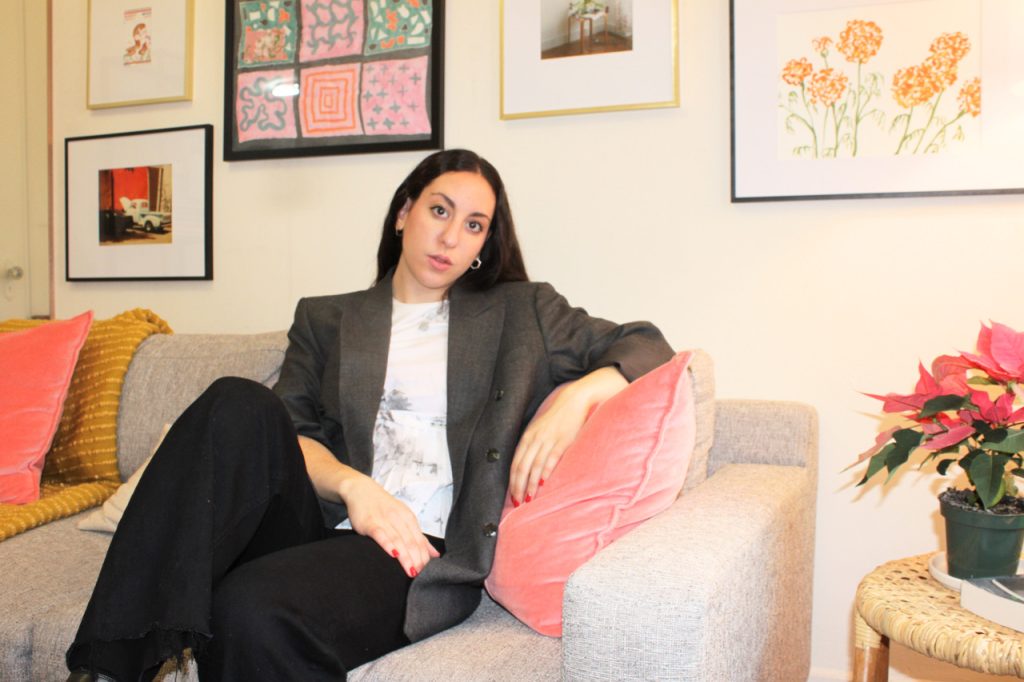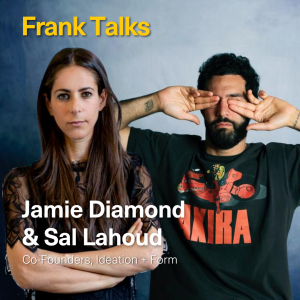We are elated to launch our 2021 Frank Talks with Audrée Anid, who is a Lebanese-American mixed-media artist and independent curator. Audrée was born in Ann Arbor, Michigan and grew up in the Bronx, New York. She has exhibited her work in group exhibitions worldwide and has held solo exhibitions in Beirut, Lebanon. Audrée has spent the last 8 years working in both the commercial and nonprofit arts sector of New York City. In 2018, she co-founded RATA Projects, an independent curatorial initiative aimed at supporting and showcasing emerging artists in New York City. In addition, Audrée is currently an Associate Director at James Cohan Gallery in New York where she has curated several exhibitions including “Borders” in January 2019, works by Nam June Paik, and exhibitions by the Palestinian-American artist Jordan Nassar. Audrée has facilitated and overseen various free interdisciplinary public programs at the gallery, including artist talks, discussions with contemporary writers and critics, and musical performances. Please enjoy reading this insightful interview below!
What was your first job in the Arts?
I worked as a part-time assistant archivist for the pioneering photographer Joel Meyerowitz.
What was the most useful or important thing you learned at that job?
I was tasked with handling thousands of digital files and physical photographs. I needed to come up with ways to tag, delineate and organize a multitude of visual information in a legible way. I still use some of the same tactics to this day.
Tell us a little more about yourself. When did you realize you wanted to pursue a career in this industry?
I’ve been making art for as long as I can remember, and still am. In my late teens and early 20s, I knew definitively that I wanted to work in the arts. I looked for opportunities to apply my analytical and organizational mind in a creative setting.
What do you do now?
I am an artist, curator, and Associate Director at James Cohan, New York. At the gallery, I work directly with some incredible contemporary artists in a support role, which includes planning exhibitions and liaising with institutions on their behalf, among many other responsibilities.
In 2018, I co-founded RATA Projects aimed at showcasing and supporting emerging artists through cohesive exhibitions.
Where are you from?
I was born in Ann Arbor, Michigan, lived in Rome briefly and finally, my family settled in New York City. My parents are from Beirut, Lebanon, and I have very strong ties to the region.
What is the arts community like there?
New York City speaks for itself as a cultural hub. I spent a lot of time visiting museums throughout my childhood in New York, and also in Beirut and Stockholm where my extended family is based. I have to thank my mother for sharing her own love of literature and the performing arts with me.
Has where you come from shaped what you do in the arts today?
Absolutely, these cities have shaped my broader outlook and have consistently inspired me.
What is the best piece of advice you can give about working in the art world?
Don’t be afraid to introduce yourself to your peers and your mentors.
What is one of your greatest accomplishments in your career so far?
The Borders exhibition I co-curated in 2019 at James Cohan was a highlight. We invited over 30 international and US based artists to participate in a show that spanned two gallery locations. The exhibition resonated at a time when our nation felt particularly polarized, which still rings true. Who better to speak to the challenges of the world then a multitude of artists who confront them head-on.
What has been a challenge for you?
Reconciling my intent to support and showcase art that is meaningful to me while also recognizing the lack of access and inequity that is prevalent in the infrastructure of the art world. I’m constantly asking myself, what actions can I take, both big and small, to make a dent in the status-quo? At a time when the world is fractured and people are struggling in this crisis, I’ve been re-evaluating what my larger role is.
What is something you do every day at the office (or your current home office)?
I like to make lists with concrete tasks outlined for myself. It helps me stay focused.
What is one of the weirdest things you have had to do on the job in your career?
In September of 2019, the gallery invited the band Sun Ra Arkestra to perform in front of an artwork by Josiah McElheny. I turned our downstairs offices into a green room for the band. 400 people came to watch them play that day.
What defines a good employee? What defines a good boss?
Clear communication is key.
What do you think makes a person hirable?
An expressed desire to contribute to the overall fabric of the workplace.
What is your advice to making yourself stand out in your workplace? Any good tips for a giving a great interview?
My advice is to speak-up and offer ideas, make yourself known.
Demonstrate why this workplace is the right workplace for you, be specific and do your research.
What is the best exhibition you have seen in the last year?
Jordan Casteel’s solo exhibition at the New Museum, which I saw a few weeks before the city shut down.
If you could own a work by 5 different artists, who would be in your collection?
Etel Adnan, Leslie Hewitt, Stephen Shore, Rinko Kawauchi, Hilary Pecis, to name a few.
What is your greatest WFH challenge? Or a WFH luxury you don’t want to lose ever again?
It’s been difficult to cope with the lack of human interaction and the incessant screen time.
What is your go to snack in quarantine? And your go to soundtrack?
Pita chips and hummus. Ariane Grande, MUNA, Kid Cudi, Tove Lo, Dua Lipa, and Rihanna, on repeat.
And finally, do you think the art world should be more transparent?
Yes, without transparency there cannot be adequate accountability. Now is the time to re-evaluate existing systems and question them and seek to improve them.




